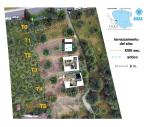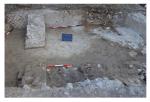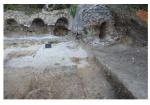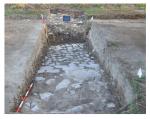Summary (English)
From 29 May to 7 July 2023, The Trasimeno Regional Archaeology Project (TRAP) excavated on the south slope of Castiglione del Lago below Via Belvedere. On the lower part of the slope the visible remains of a terrace wall with four arches and water channel, both in opus mixtum, attest to Roman Imperial construction, ca. A.D. 100. The site is locally known as “Le Buccace” and Dr. Walter Pagnota documented the structures in his 1984 publication. Although archaeologists have long presumed that Castiglione del Lago was a Roman, and possibly Etruscan, settlement, evidence for extensive Roman occupation in the town is lacking.
From Via Belvedere Sud to the base of the hill, the slope is cut into six terraces supporting an olive grove (Fig. 1). It appears that those terraces, which were formed in the 1700s, were created by filling in and then recutting previous terraces from the Medieval and Roman periods, effectively preserving those earlier occupation phases. In 2023, TRAP excavated on three of the terraces with two goals: first, to understand better the function of the arched structure and adjacent water channel; and second, to determine the extent and nature of Roman occupation on the slope.
On Terrace 4, where the arched structure and water channel are visible, cleaning and excavation in front of the arches and to the west of the water channel revealed that the Roman floor level had been completely destroyed. However, a foundation trench in front of the arched structure suggests that there was a shed-like roof. In addition, evidence of dolia pits indicate that this area was likely dedicated to the processing and storage of foodstuffs, probably fish from the lake. While it seems possible that there were water basins in front of the arches, there is no such surviving evidence. The adjacent water channel, which does not continue further to the south, initiated from two terraces above (Terrace 2) where a collection basin (partially visible below the split trunk of an olive tree) would have directed water into the channel.
Excavations on Terraces 2 and 3 revealed that the occupation of the slope in the Roman period was much more extensive than previously suspected. Moreover, ceramic material indicates that the slope may have been in use as early as the middle of the 6th century B.C. On Terrace 3, above and on the same orientation as structures below, a series of opus mixtum walls form a complex of at least six rooms. Due to the depth of preservation, we were not able to reach the Roman floor levels. Remnants of late Antique or Medieval mortared surfaces against the Roman walls indicate that the Roman complex was abandoned for a period of time and then reused. While it is likely that this complex was part of an Imperial period villa, further excavation is required.
On Terrace 2, excavations around the area where the water basin is located revealed a cobbled surface approximately 0.70 m below modern ground level. The extent and function of this surface remain to be determined. Two the south, the surface runs up to a concrete wall that appears to form the terrace wall between this level and Terrace 3 below. The ceramic material recovered from the stratum just above the surface includes fragments of impasto, bucchero, and black-glaze wares; Roman Imperial wares are notably absent, suggesting that the cobble surface may predate the Roman occupation of the slope and may not have been reused when the Roman complex below was constructed. Again, further study is required. Rebecca Schindler
- Rebecca Schindler- Professor of Classical Studies, DePauw University, Indiana, United States
Director
- Rebecca Schindler- Professor of Classical Studies, DePauw University, Indiana, United States
Team
- Giampiero Bevagna - Umbra Institute
- Pedar Foss - DePauw
- Stefano Spiganti-Associazione Acqua
Research Body
- DePauw University (Indiana, US)
- Umbra Institute (Perugia, IT)
Funding Body
- Comune di Castiglione del Lago
- DePauw University
- Umbra Institute






![Download [PDF]](/excavation/skins/fasti/images/results/download_sml.png)


